Mar 18, 2013 | street art
Three of the Angry Birds sit on a wire. They look just as unhappy as they do on your iPhone, except we’re not the ones controlling them and they don’t seem to have much of a purpose with no blocks or green elephants to knock down. Here they’re perched on the edge of an actual wire fixed to the outside of this building – gray followed by red followed by yellow – three little puffs of color with makeshift tails and upset eyes. There’s no reason for them to be angry on this wall but otherwise we might not recognize them.
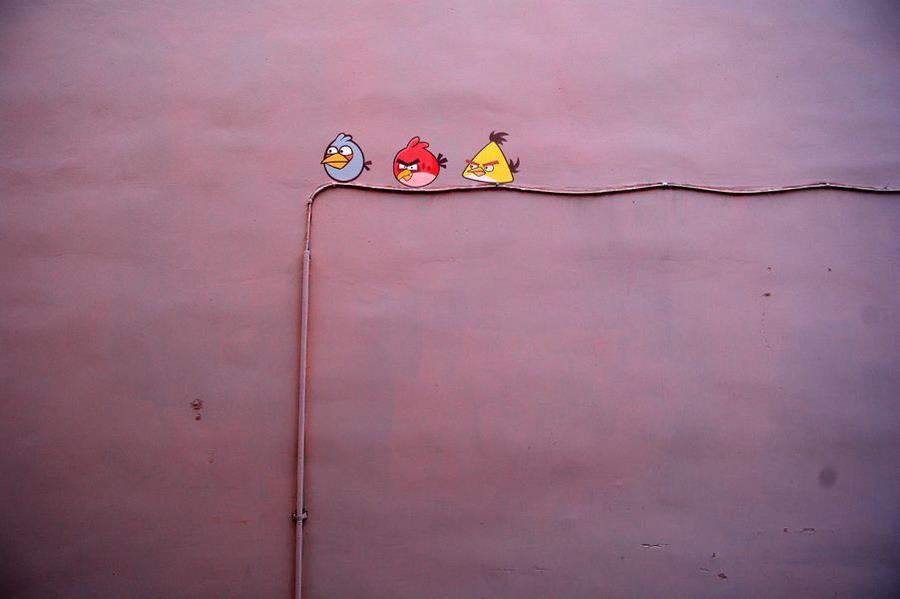
Alexey Menschikov is a Russian artist peppering the streets with his brightly-colored art while pursuing photography in black-and-white. He turns something physical about a fence or a wall into the starting point for each drawing, combining something that’s actually there with something two-dimensional, merging his imagination with reality in a public place. Often these physical lines start out as cracks or wires, but Menschikov turns them into ground lines and tree branches and perches birds or shapes or shadows on top.
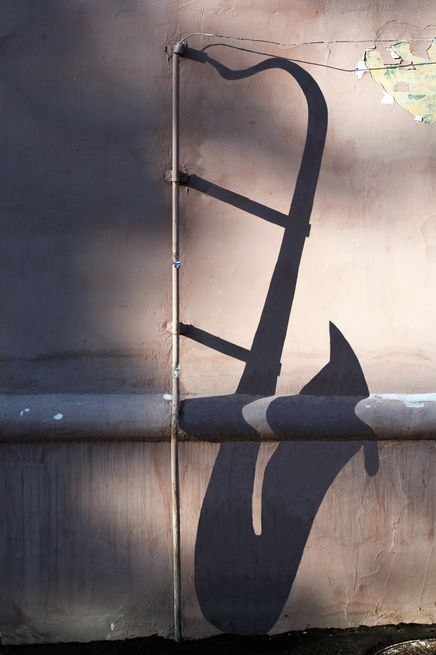
The saxophone is the subtlest of them all, each of the three brackets that hold the pipe to the wall stretch out to hold up the painted shadow of a make believe musical instrument – turning something ugly and functional into the idea and shape of something beautiful. The saxophone’s slender neck slips down to ground-level and loops up.
The little yellow bird that sits on cracked red pavement has his eyes closed. The tree branch he struts across has only become more than a crack in the ground because of one little painted bird.
Alexey’s second pavement crack turned tree branch happens on gray ground – the little tree reaches up from the manhole cover that caused the crack, and it’s painted with pale green leaves. On the right branch sits two little owls, one mommy and one baby, both with eyes wide open and green-yellow bodies simply decorated.
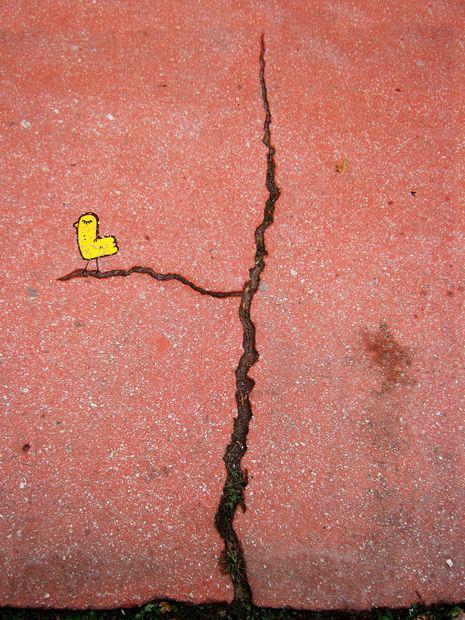
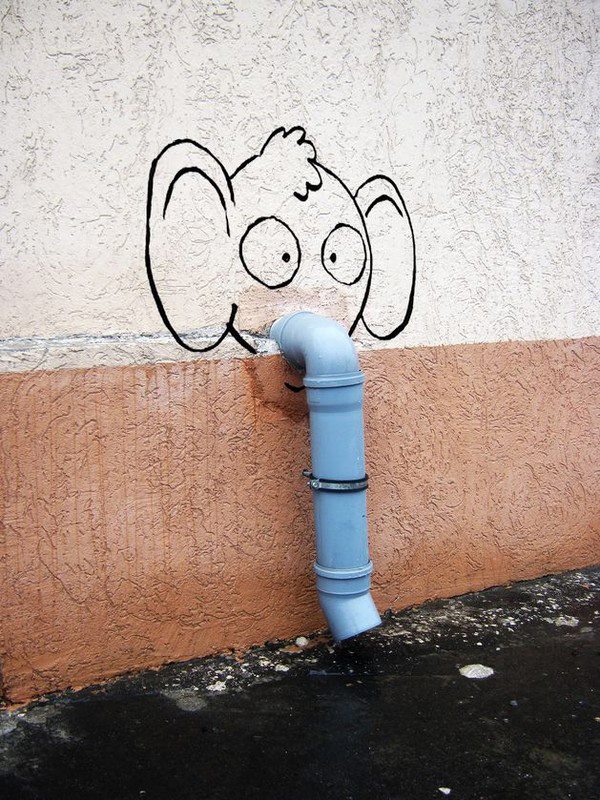
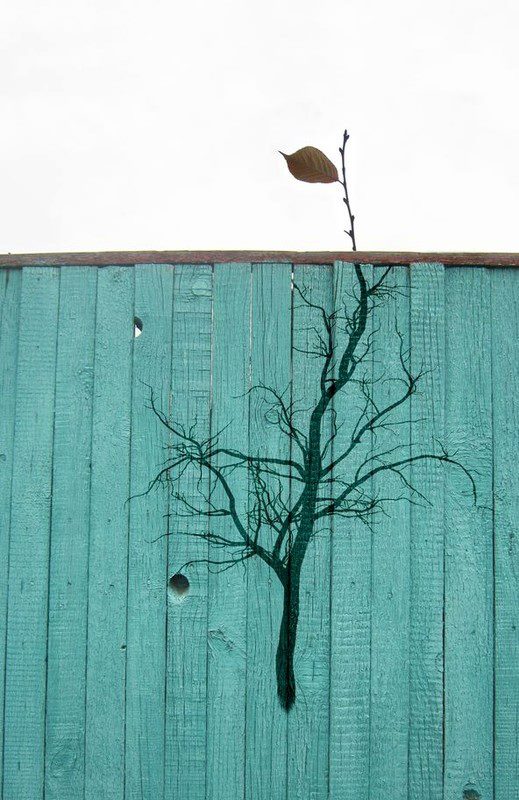
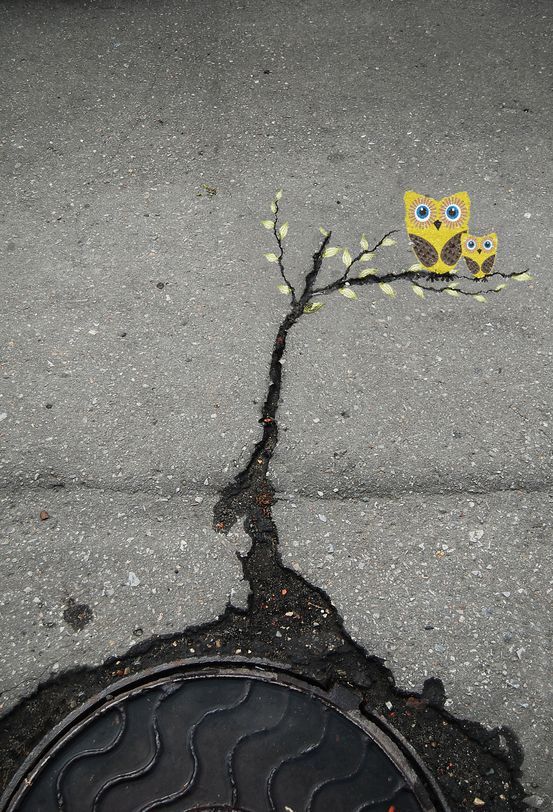
All images from the artist’s Live Journal.
See Alexey’s Facebook page for more of his work.
GD Star Rating
loading...
Feb 21, 2013 | illustration, interviews
Contemporary artist Shari Rubeck uses watercolor and acrylics to create simple scenes filled with glamour, curiosity and chaos. Each brightly colored artwork beautifully explores the human psyche, with a suggested meaning that’s left open to interpretation . Her style is multi-faceted, each series develops its own sort of visual voice that usually involves some kind of animal imagery along with a sense of raw purity, the paint allowed to run and swirl organically in confined areas of the composition.
“Lion Girl” is a watercolor and graphite work that shows a woman standing defiantly, hands on her hips as her serene face is overlaid with that of a powerful lion roaring, the color of his mane melting into her fiery tethered dress. A girl in a blue dress leans impossibly far to the right in “Sharp Intrusion,” her head hidden by a glowing red space helmet with five birds flying towards it, as if they were working as a team to knock her over.
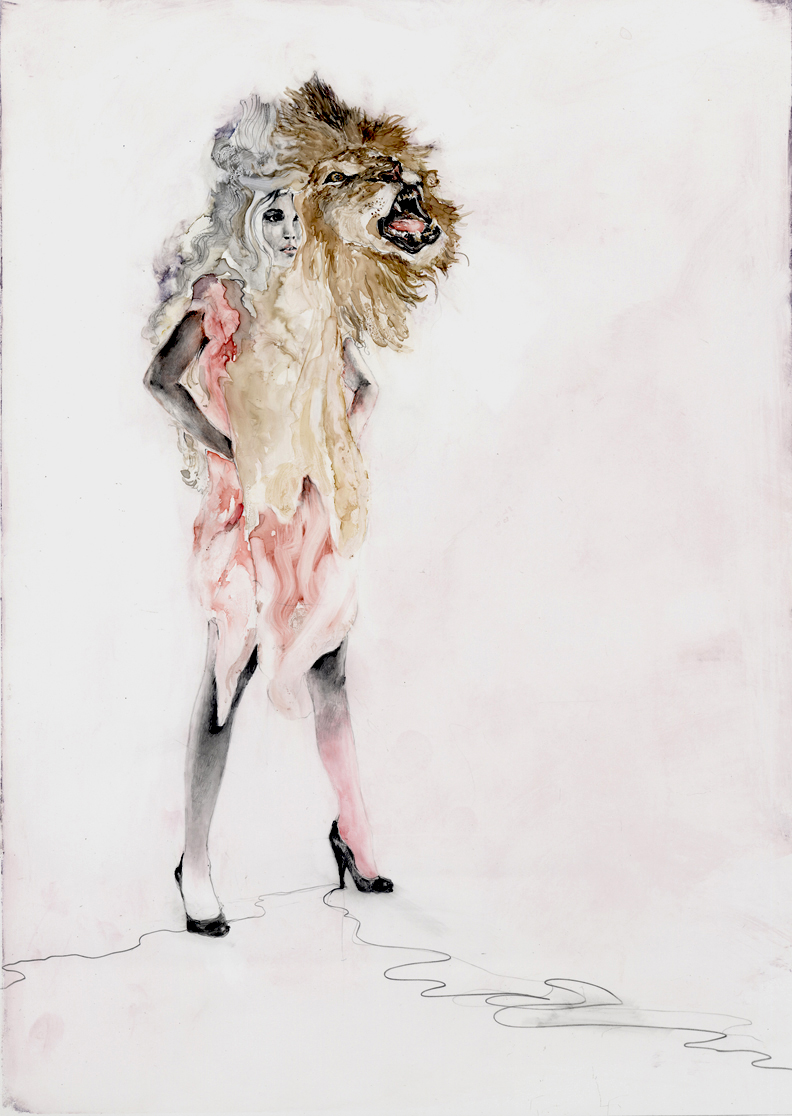
What’s the first thing you can remember painting?
The inside of my parent’s station wagon with crayons is one of my earliest artistic memories. But my first memory of painting would have to be when I received a good quality set of brushes and went to town filling large pieces of watercolor paper with all varieties of brushstrokes until I could think of no more.
What do you think watercolor adds to the creation of a piece?
Watercolors are fresh, light and have an immediate quality. I am working to bring that sense of luminescence to some of my larger acrylic paintings on linen.
What do you like about including animals in your work? Particularly bunnies?
Animals are a big part of my life and psyche. They are present often in my thoughts, dreams and work. They are my connection to the subtle workings of the world. They are magical, intuitive, and fierce, connected and make wonderful story tellers. As a human race we have turned our backs on them. Should technology suddenly drop off we would look to them for knowledge, guidance and find ourselves thanking them once again for sustenance.
The Bunnies arrived on the ‘scene’ soon after I began ‘working’ a puppet, named ‘Bunny’ for my son in his struggle to find comfort of sleep at bedtime. Bunny has a tremendously silly, but slightly cynical sense of humor and became my artistic story teller. The bunnies illustrate humor in the serious and not so serious sides of life’s events and emotions.
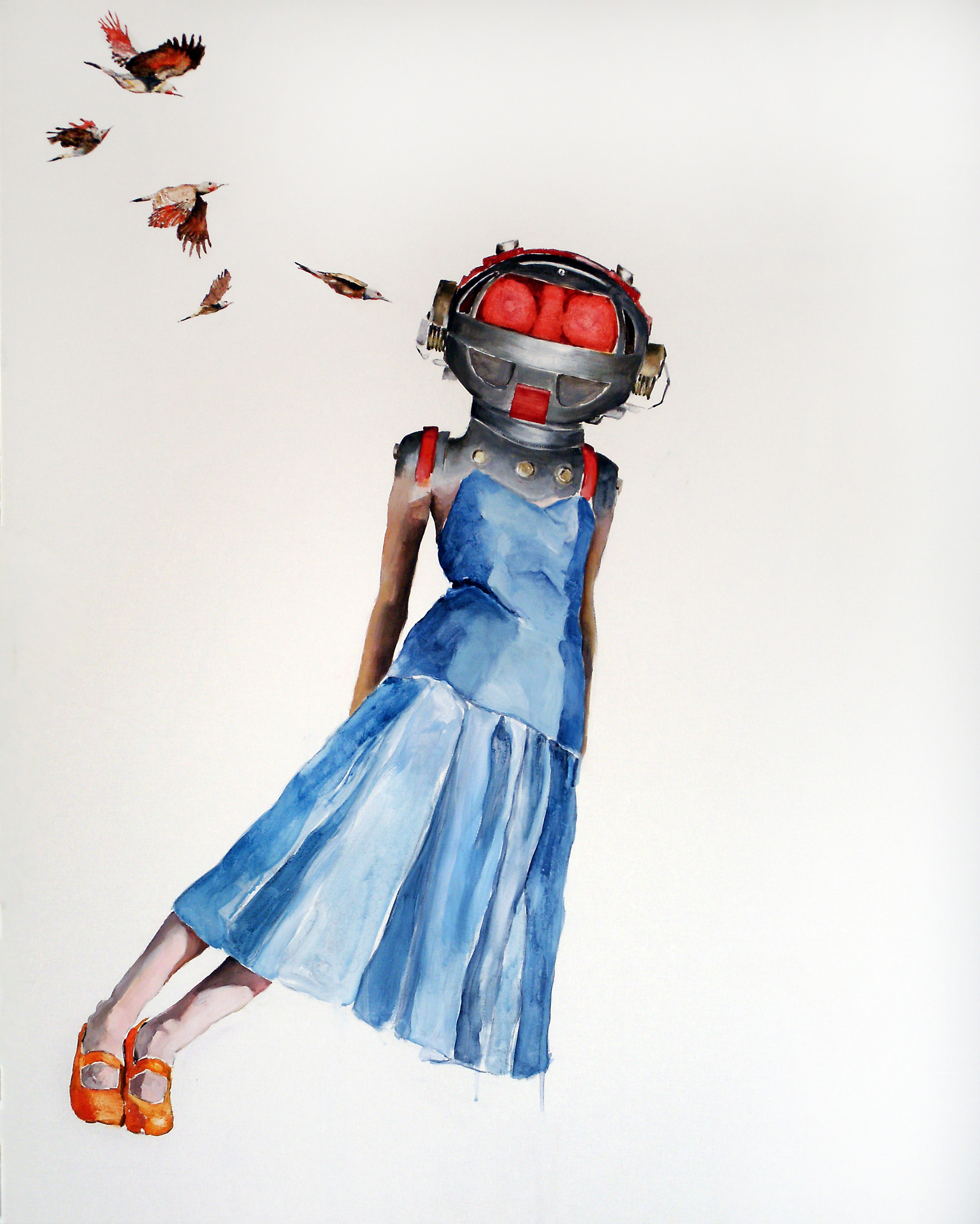
Who are the people your works represent?
The figures in my work represent all of us – humans and humanness. Some pieces are more representative of my own self and direct experiences, while others are observations from distant perspectives.
What do empty backgrounds allow for in your work and how do you choose a background for each character?
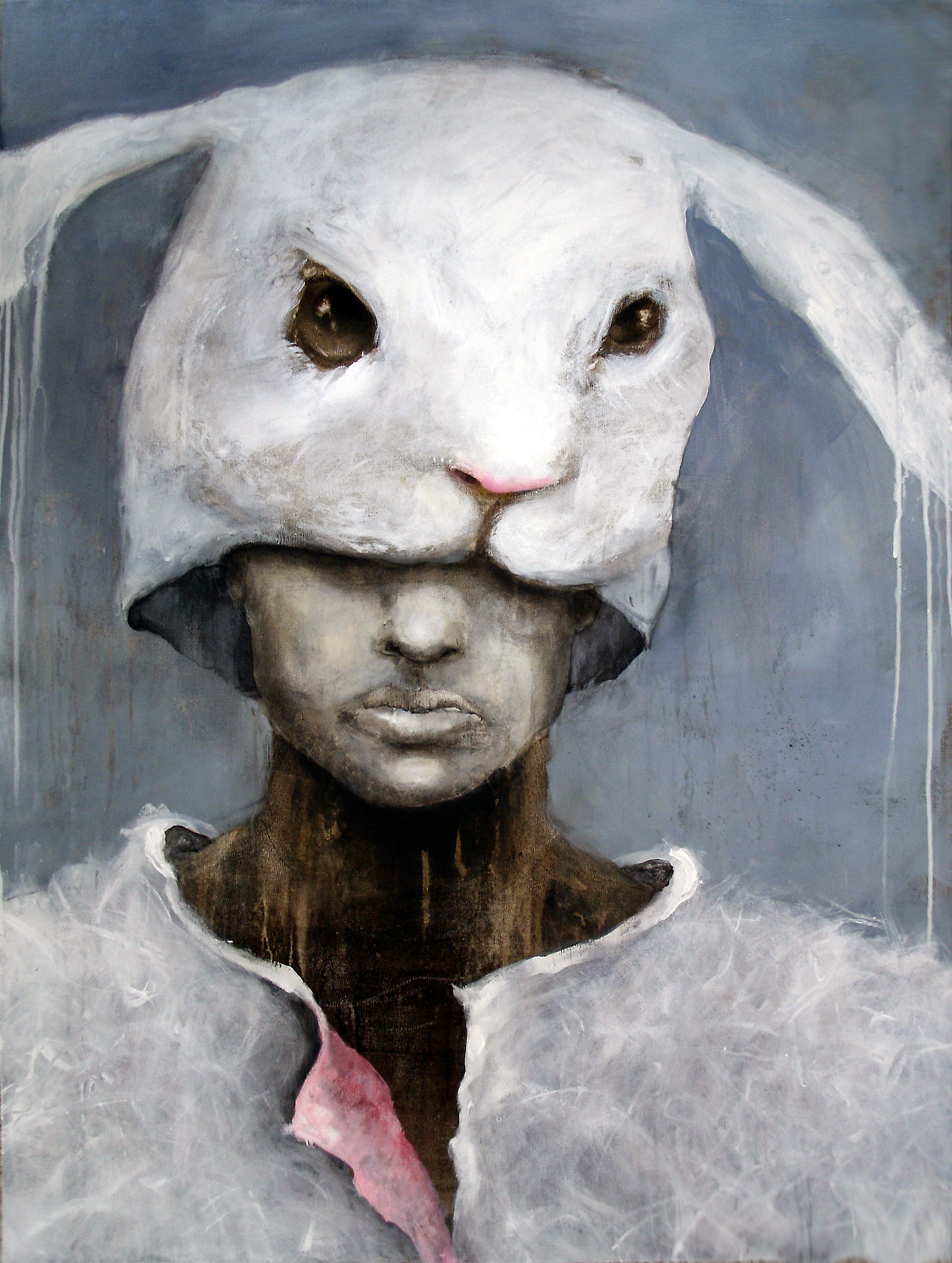 I fluctuate between giving color & detail to the areas surrounding my characters and leaving them alone in their space. An intense drive to express an idea, message or observation leaves me feeling that the figures can communicate strongly without anything around them. The blank or negative space is carefully considered and tells much about the tensions while simultaneously allowing for areas of visual repose.
I fluctuate between giving color & detail to the areas surrounding my characters and leaving them alone in their space. An intense drive to express an idea, message or observation leaves me feeling that the figures can communicate strongly without anything around them. The blank or negative space is carefully considered and tells much about the tensions while simultaneously allowing for areas of visual repose.
What do you like about the image of a figure with a mismatched head?
A figure with mismatched head…isn’t that what we all are? Or I could elaborate and say that we are all different degrees of mask wearers. My Ego series transformed into the Alter Egos. The first Alter Ego shows a human wearing a bunni mask or a bunni wearing a human – there is some ambiguity. I have always been intrigued by masks and what they can represent. There is so much that goes on ‘backstage’. I do also love the weight of a head that is too large for its body; whether mechanical or creature.
What are some of the art websites or blogs you follow?
Some sites that I am affiliated with or keep up with are: BlueCanvas, Twitter, ARTCZAR, Elisa Contemporary, Artsrogueisland, GalleryZ, ColoColo, Hallway Gallery, and now of course ThingsWorthDescribing. I find many intriguing sites on random searches but may only visit them once.
Minor Situations is her newest series of bunny paintings that’s by far the most adorable – fluffy floppy characters shown after a small disappointment like burning toast, letting balloons go, or spilling milk. Their little bunny faces look so downtrodden, and their long ears allow for an exaggerated sense of unhappiness as they fall down the back of every bunny. Simple scenes against bright-colored backgrounds, these works are lovable in a silly sad way.
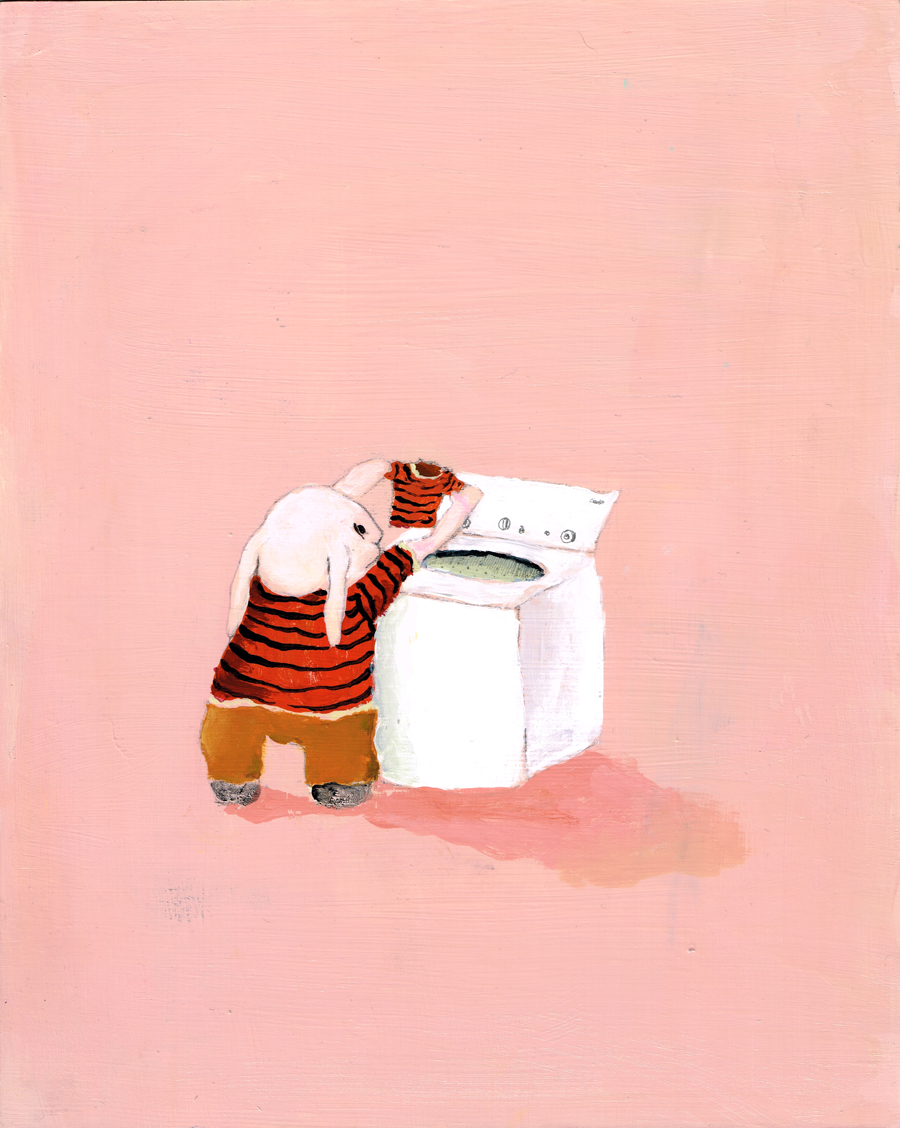
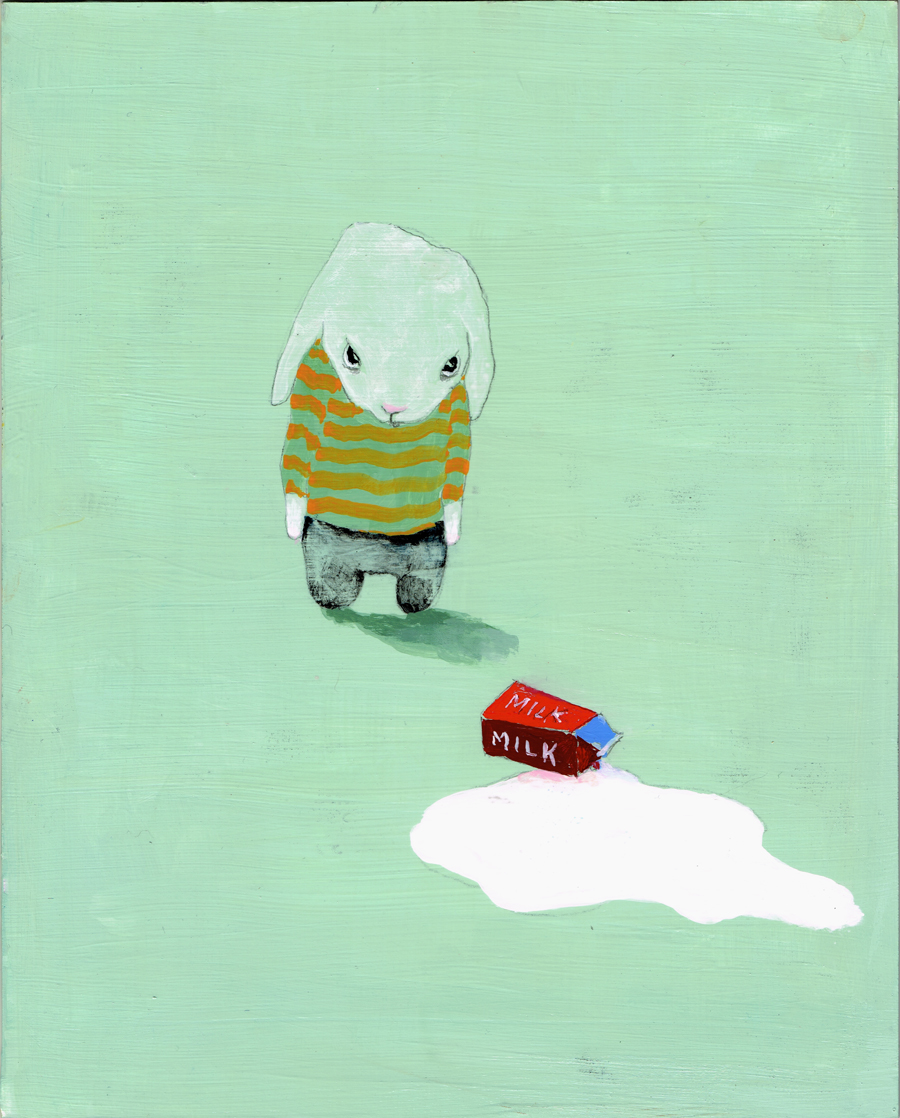
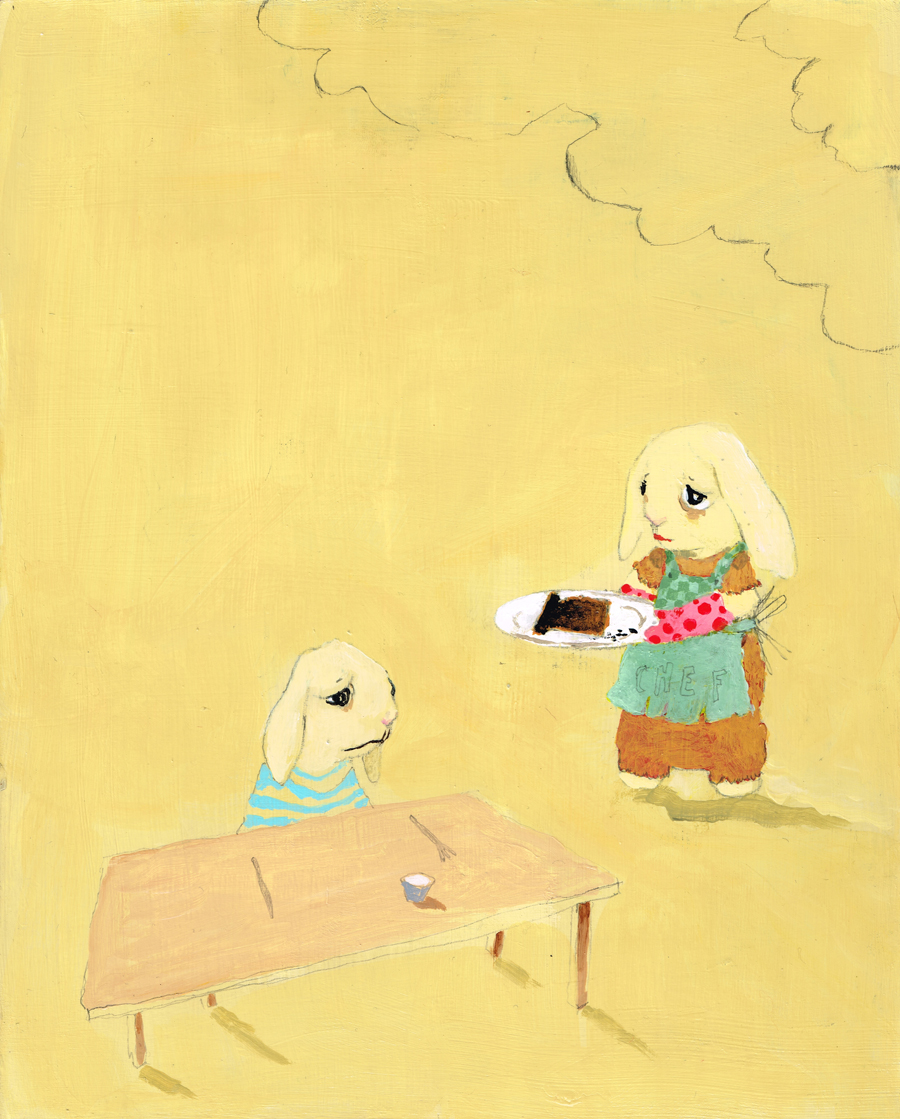
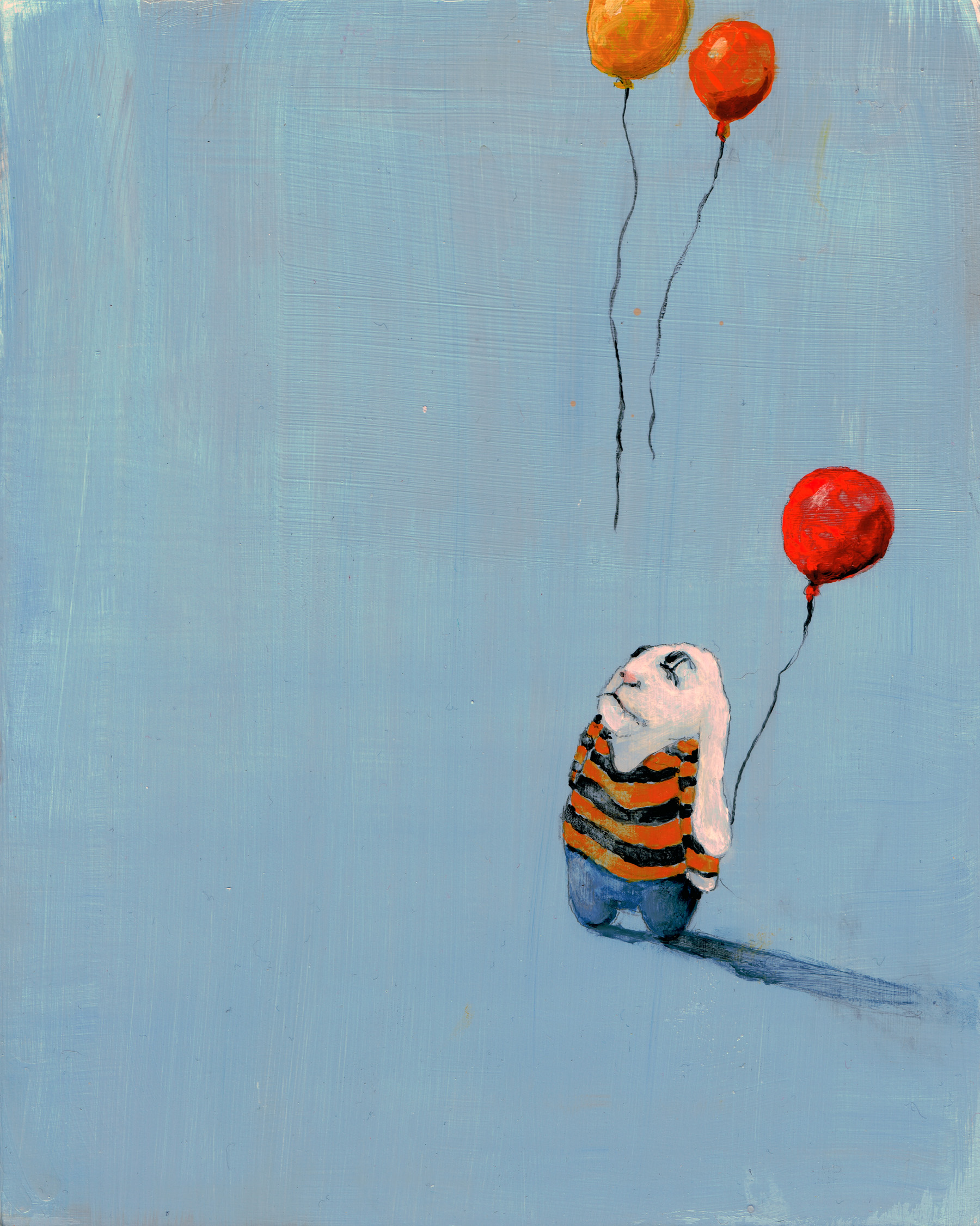
For more of Shari’s work, head to her website Art in Mind.
GD Star Rating
loading...
Feb 18, 2013 | painting
These characters come from the 1699 French novel Les Aventures de Télémaque that fills a gap in Homer’s Odyssey, telling of Ulysses son Telemachus’ educational travels with a mentor that turns out to be the goddess of wisdom Minerva. The author Fénelon tells of how Telemachus fell in love with this beautiful nymph Eucharis but his duty as a son demanded that he leave her and find his missing father.
In this scene they say goodbye, an image that David makes so powerful and real with a warm white light that sets their light skin aglow. Telemachus stares straight out at us, his face still babyish and framed by blonde curls, like a lamb who doesn’t know to be scared as it’s naively lead toward slaughter. That’s not what happens in this story though. Telemachus is rewarded for sacrificing in the name of his father, and at the end of the story he learns his mentor has been the goddess of wisdom this whole time and he reaches Ithaca safely and smarter and stronger than ever.
Eucharis wraps her arms gently around his neck, leaning her head on his shoulder, eyes downcast because she knows she’s about to be left behind and there’s nothing she can do about it. Telemachus has his right hand placed gently on her leg as a temporary consolation prize, holding his spear in the other hand, fingers spread across it as he leans back and acknowledges the viewer with his sad blue-eyed stare. A skinny ghost of a dog peeks his head out of the darkness in the right-hand corner, staring up at his master as another faithful admirer, but perhaps one that actually gets to come along.
This painting currently belongs to the Getty Museum in LA whose website reads, “David painted The Farewell of Telemachus and Eucharis during his exile in Brussels. The use of saturated reds and blues contrasted with flesh-tones and combined with a clarity of line and form typifies the Neoclassical style, which is characteristic of David’s late history paintings.”
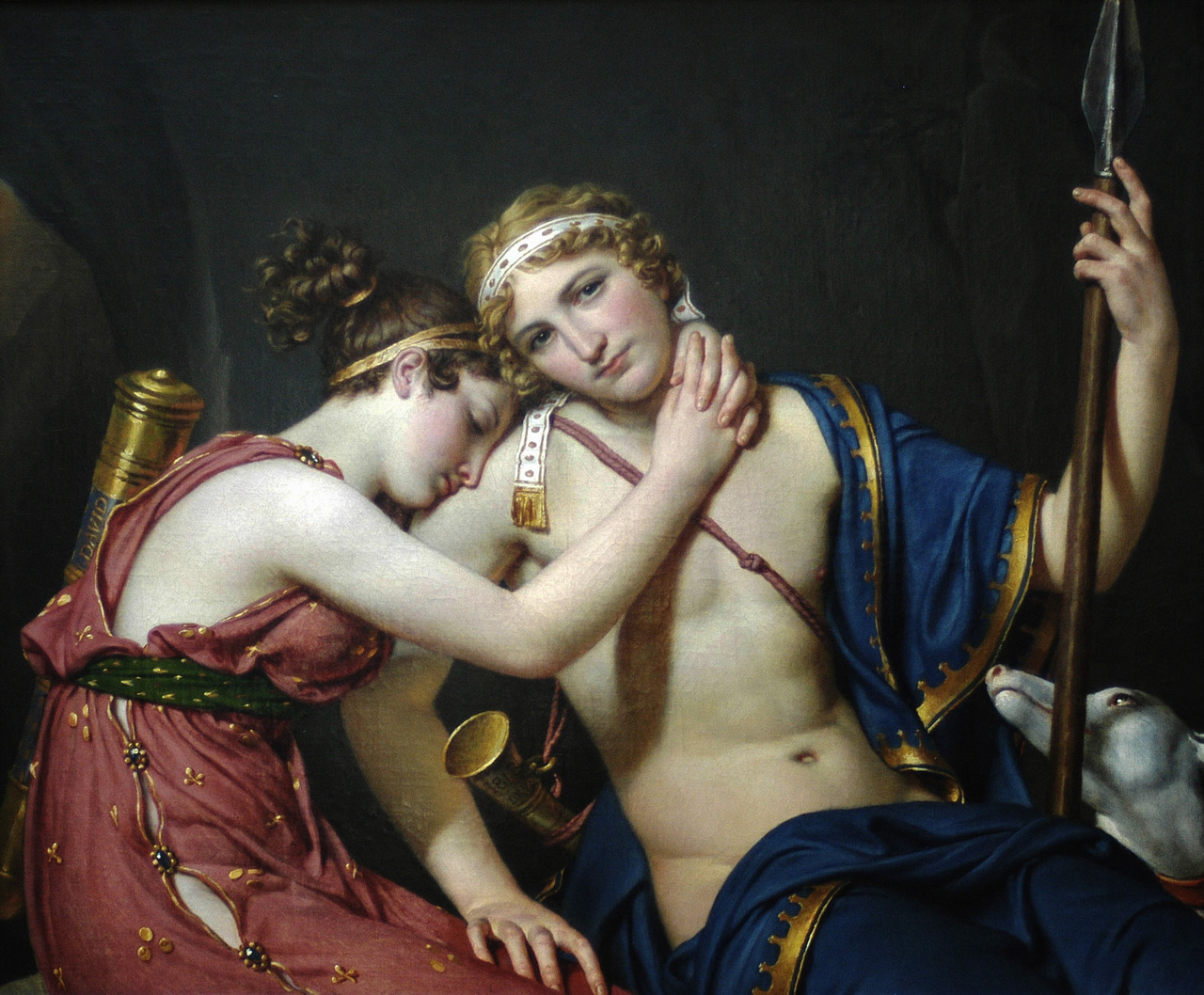
“The Farewell of Telemachus and Eucharis” by Jacques-Louis David
French, 1818
Oil on canvas
34 1/2 x 40 1/2 in.
For corrections and additions to my telling of this French novel, please email me. I did a good amount of research but unfortunately I can’t speak French and may have got a few things wrong.
GD Star Rating
loading...


















